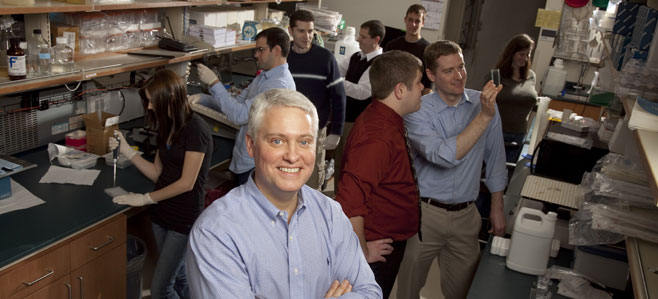
Dr. Douglas McNeel, foreground, and his team at the Wisconsin Institutes for Medical Research have been investigating ways to help the body battle prostate cancer.
About a third of men treated for prostate cancer have the disease recur at some point.
Dr. Douglas McNeel and his team at the Wisconsin Institutes for Medical Research (WIMR) have been targeting ways the body might fight off prostate tumors. “If we basically teach the body to recognize the cancer as something bad and reject those cells, that’s the ultimate goal of vaccines,” he said.
McNeel’s work to battle prostate cancer is emblematic of the promising research and fruitful collaboration taking place at WIMR. One idea powering the research is to develop a vaccine that could be used after detecting a rising PSA level, a harbinger of returning cancer.
Treatments for advanced stage cancer such as chemotherapy and radiation have unpleasant side effects. Patients with prostate cancer “can do well for a long period of time, so there’s a chance to intervene with another therapy that might take time,” McNeel said.
“We’re looking at what the simplest means of delivery is, and we’ve settled on DNA as a way to deliver that target antigen for the right kind of immune response,” said McNeel, whose work has been funded through the Prostate Cancer Foundation and the National Institutes for Health, among other sources.
The vaccine therapy is in various clinical trials. “With tumors, we’re trying to overcome a barrier,” he said. “What we’re targeting are things the immune system normally sees, so we have an additional challenge. They’re a different kind of vaccine, requiring different kinds of questions. We’re learning a lot.”
WIMR director Rick Moss is excited about the possibilities. “I think Doug’s work is spectacular,” he said. “The key is translating this into therapies that help people, and it looks like that is going to happen.”
“Proximity to the hospitals on the medical campus leads to tactical and strategic relationships that will yield great benefits.”
Rick Moss
More efficiently moving research from the lab to the patient is one of the organizing principles of WIMR, which one day will encompass three towers. Like all the researchers at the institute, McNeel and his team—spanning scientists, postdoctoral fellows, transplant immunologists, and graduate and undergraduate students—work in an open, sharing environment.
The first WIMR tower is dedicated to cancer research. The second tower, under construction, will move the McArdle Cancer Laboratory from a location across campus to a more natural spot next to the Carbone Comprehensive Cancer Center in Tower I. Tower II, which requires $24 million in gift funds to complete, also will house cardiovascular research, stem cell and regenerative biology, and neurobiology investigation into such areas as epilepsy, Parkinson’s disease and hearing impairments.
“Proximity to the hospitals on the medical campus leads to tactical and strategic relationships that will yield great benefits,” said Moss, noting that WIMR’s cancer research already has generated many disclosures of inventions that the Wisconsin Alumni Research Foundation is looking to patent. “The joining of basic scientists, clinical researchers and physicians is not an accident. Interactions between the School of Medicine and Public Health and other key elements of campus truly are advancing knowledge and practice in ways that will yield great benefits to society in the years to come.”
